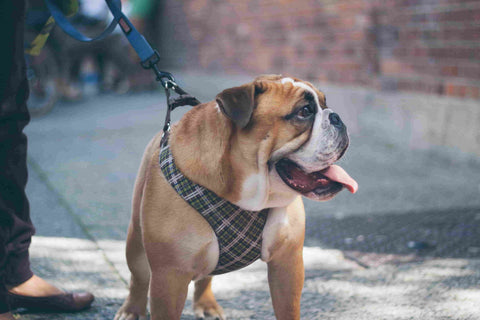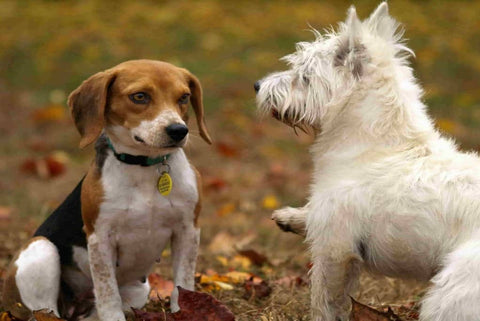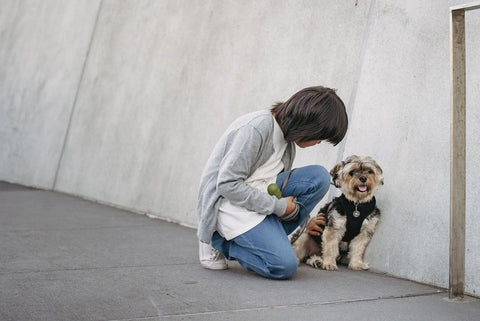How to Properly Use a Front Clip Dog Harness
For a good reason, front clip dog harnesses have become increasingly popular in recent years. These harnesses offer several benefits over traditional rear-clip harnesses, including greater control and less pulling.
When used correctly, these dog harnesses can be excellent for training your dog and teaching them to walk calmly by your side. If you're thinking about switching to this dog harness or are simply curious about how they work, read on for everything you need to know.
When Should You Use a Front Clip Dog Harness?
There are a few situations where a front clip dog harness can be helpful.
If your dog is a puller, a front clip harness can help you gain better control if your dog likes to pull on the leash. By attaching the leash to the front of the saddle, you can steer your dog more efficiently and prevent them from dragging you down the street.
A front-clip harness might give you more control on walks if your dog is powerful. This might be especially useful if you reside in a city with heavy traffic.
A front clip harness may be a useful training tool for your dog. It may be simpler to teach your dog commands such as "heel" and "sit" with the additional control. Additionally, it is advantageous for leash training and sidewalk training.
In some cases, when your dog is sick, your veterinarian may recommend using a front clip harness if your dog has an illness or medical condition that makes walking difficult. For example, dogs with hip dysplasia may benefit from a front clip harness because it takes the pressure off their hips and joints.
Whenever you use a dog harness that clips in front, it's essential to start slowly and gradually increase the amount of time you use it. You don't want to overwhelm your dog or cause undue stress, so take things slowly at first and let them get used to the new harness.
Choosing the Best Front Clip Harness for Dogs
When choosing a front clip harness for dogs, there are a few things you'll want to keep in mind. First, consider the size and weight of your dog. You'll want to make sure the harness is comfortable and not too tight. You'll also want to consider the activities you'll use the harness for. If you're doing a lot of hiking or running, you'll want a harness designed for those activities.
Finally, consider the materials the harness is made from. You'll want something durable that won't rub your dog's skin raw. Not all front clip dog harnesses are created equal! When choosing a harness for your dog, it's essential to consider the following factors:
Take Proper Measurements
The best way to ensure you choose the correct size harness for your dog is to take proper measurements. To do so, follow these steps:
- Measure your dog's chest: Using a flexible tape measure, find the widest part of your dog's chest. This is usually behind their front legs.
- Measure your dog's neck: Wrap the measuring tape around the base of your dog's neck, keeping it snug but not too tight.
- Check the sizing chart: Once you have your dog's measurements, consult the manufacturer's sizing chart to find the correct size harness for your pup.
Pets Radar suggests measuring your dog a few times because posture and positioning can affect the outcome. For the most accurate measurements, enlist the help of a second person to hold your dog still while you measure.
Consider the Design & Functionality
In addition to size, you'll also want to consider the design and functionality of the front clipping dog harness.
Design: Look for a harness made from durable, breathable materials such as mesh or nylon. You'll also want to ensure the harness is adjustable to get a snug but comfortable fit.
Functionality: Consider what you'll be using the harness for and choose one with features that suit your needs. For example, if you're training your dog, you may want a harness with a front ring that doubles as a handle so you can easily control your pup.
Adjust the Harness Fit
Once you've chosen the proper front clip dog harness for pulling, it's time to adjust the fit. To do so, follow these steps:
- Place the harness on your dog: Put the harness over your dog's head and secure the buckle around its chest.
- Adjust the straps: Once the harness is in place, tighten or loosen the straps as needed to get a snug but comfortable fit. You should be able to fit two fingers under the straps. To ensure your dog is relaxed, check out our guide on how tight a dog harness should be.
- Attach the leash: Finally, attach the leash to the front ring of the harness, and you're ready to go.
What’s the Difference Between a Dog Harness That Clips in Front vs. Back?
The placement of the leash attachment is the key difference between a front clip and a back clip harness. As the name suggests, a front clip dog harness has a leash attachment in the front, while a back clip harness has a leash attachment at the back.
A back clip harness is the most common type of dog harness. The leash attaches to a ring near your dog's shoulders at the top of the saddle. This harness is easy to put on and take off and offers reasonable control for most dogs.
A front clip harness has a leash attachment near your dog's chest at the front of the saddle. This type of harness can be helpful for dogs that pull on the leash or for obedience training. It's also a good option for dogs with hip dysplasia or other medical conditions that make walking difficult.
No matter what type of harness you choose, take proper measurements and adjust the fit for a snug but comfortable fit. At Pet&Cuddle, we offer double-clip harnesses that provide the best of both worlds - the control of a front clip harness with the comfort of a back clip harness.
Get the Best Front Clipped Dog Harnesses at Pet&Cuddle!
A dog harness that clips in front is a great way to help your dog stay comfortable and safe while on walks. They can also help train your dog not to pull on its leash. When using a front clip harness, it is crucial to ensure that the harness fits properly and that you use it correctly.
If you're looking for the best front clip dog harnesses, look no further than Pet&Cuddle. We offer a wide selection of dog harnesses that fit your pup's needs.
Our harnesses are made from durable, breathable materials and feature adjustable straps for a comfortable, custom fit. We also offer double-clip harnesses that provide the best of both worlds - the control of a front clip harness with the comfort of a back clip harness.
Common Questions About Front Clip Dog Harnesses
You want what's best for your furry friend like most dog owners. That's why you're considering a front clip dog harness. But you may still have questions about whether this is the right choice for your pup. Why use a dog harness that clips in front? Below are some commonly asked questions on the topic.
How does a front clip dog harness work?
Front clip dog harnesses, or no-pull dog harnesses, work by changing the leverage point. When the dog pulls, the harness redirects them to the side. The purpose of a front clip harness is to give you more control over your dog by making it easier to turn their body away from something. When your dog pulls on the leash attached to the front clip, they pivot around its chest toward you.
Should I use a front clip harness for large dogs?
A front-clip harness gives you more control over your dog's movements, making it ideal for big dogs or those that are poorly behaved or in leash training. According to Pet Helpful, a harness helps to distribute the weight evenly, making it a more comfortable choice for dogs of all sizes.
Do front clip harnesses help with pulling?
Yes, the front clipping dog harness help with pulling. By attaching the leash to the ring in front of your dog's chest, you can redirect their attention and better control their movements. This harness is also helpful for dogs that tend to pull to one side or need extra support while walking.
Do front clip harnesses cause arthritis?
Love to Know notes that a dog harness designed specifically for senior dogs helps to distribute the weight away from their painful limbs and makes it much simpler for you to help them get around.
The harness sits on top of vital muscles, including the biceps, brachiocephalic, and supraspinatus. These contribute to extending the shoulder joint. However, if the fit is poor, it can restrict motion and cause shoulder pain, arthritis, inflammation, and bursitis.




